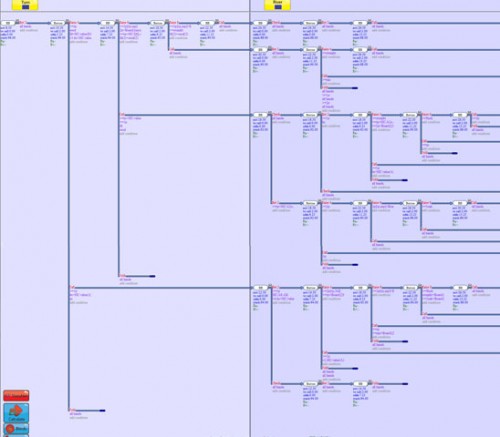Texas Hold’em is an extremely simple to learn game, but is actually very complex. The number of possible ways a single hand can play out is just mind boggling.
I recently created a simulation for a very specific turn + river scenario. A screen shot of the turn and river decision tree is shown below. This simulation used a lot of approximations and assumptions, leaving out many of the possible details one could possibly consider. Even so, you can see the decision tree quickly explodes into many different possibilities.

Given how many different paths one can take to get to the river, it makes sense that one will often arrive there with unbalanced ranges, leading to unbalanced actions.
I recently noticed that one of my regular opponents never seemed to pay me off in the following situation: I raise preflop and my opponent 3-bets from the SB making a heads-up pot. I flop some kind of weak made hand on a relatively safe board and call his bets on the flop and turn. On the river he checks to me, I make a value-bet presumably against an A or K-high hand, and he folds. I quickly jotted this down on a post-it note.
Later that day I went into Hold’em Manager, loaded up my opponent, and set the appropriate filters:
- Position: Small Blind
- Preflop Action Facing Player: 1 Raiser
- Position of 3-bet: Small Blind
- Filter by Flop Actions: Bet
- Filter by Turn Actions: Bet
- Additional Filters: Saw River=True
This gave me all his Small Blind defense hands where he gets to the river with his opponent calling single bets on the flop and turn. I then sort the hands by river action and can quickly compile the following information:
- How often does my opponent check the river in this situation?
- When faced with a bet, how often does he call, fold, or check-raise?
- With what type of hands and on what boards is he check-calling or check-raising the river?
For this particular opponent, I found that he checks the river about 25% of the time in this situation. When he does check, he folds about 2/3 of the time when faced with a bet, calls 1/3 of the time (always with an A-high type hand), and never check-raises.
With this information we can confidently make thin river value-bets (with weak pairs), knowing that we will sometimes get paid off by A-high, and that we will never get check-raised and put to a difficult decision. Also, because of the fairly high fold rate on the river, we can sometimes choose to delay our semi-bluffs, drawing passively on the flop and turn and then bluffing the river when checked to.
Because the opponent folds so often vs a river bet, this effectively adds about 16% of equity to our draw before the river… Our opponent checks the river 25% and folds to a bet 66%, so 0.25*0.66 = 0.165.
16% is an optimistic value though, since our opponent will tend to check and call more often on the river when the obvious draws have missed.
There are many other river scenarios that I’ve been keeping my eye on as well, hoping to find exploitable tendencies in the opponents I compete with day in and day out.

I like the idea of delaying bluffs/semi-bluffs to the river in general. Overall we get a cheaper price on our bluffs because we’re never calling a river raise whereas if we raise on the turn and get 3-bet we are calling with our semi-bluffs. I also like that we very rarely get 3-bet bluffed on the river opposed to getting 3-bet bluffed some of the time on the turn – we get the last bet in a lot when we are both drawing in other words. Also we have the additional information of seeing a river card which might change our decision to bluff or semi-bluff and save us some money. Another benefit I see is that it balances our river raising better which is generally super strong. The flipside though is that our turn raising range gets value heavy and if we’re up against good opponents who recognize this, they can start making a lot of laydowns – of course we can just move our bluffs back to the turn if this is the case. Also a drawback is that the river card might cause our opponent to call where he would of otherwise folded the turn.
All in all though, I think the delayed semi-bluff is a really valuable weapon and very underused in our games. I wouldn’t be surprised to see this play used a lot more frequently by players in the future.
Awesome post! My study hours have dwindled in 2011, so hopefully this inspires me to get some work done.
kc
Seems like sample size would be a limiting factor here. How often does this situation come up vs. a specific guy?
Hi Paul,
I am not a stats expert, but you do have a good point that this is an extremely specific scenario and that usually it will be difficult to get a large enough sample size. This particular opponent is a regular in the games I play and has been for as long as I can remember.
When I ran the filter as described I think I got around 15 instances where my opponent bet/bet/check on the flop/turn/river. So yeah, still a pretty small sample but I think good enough to draw some useful conclusions.